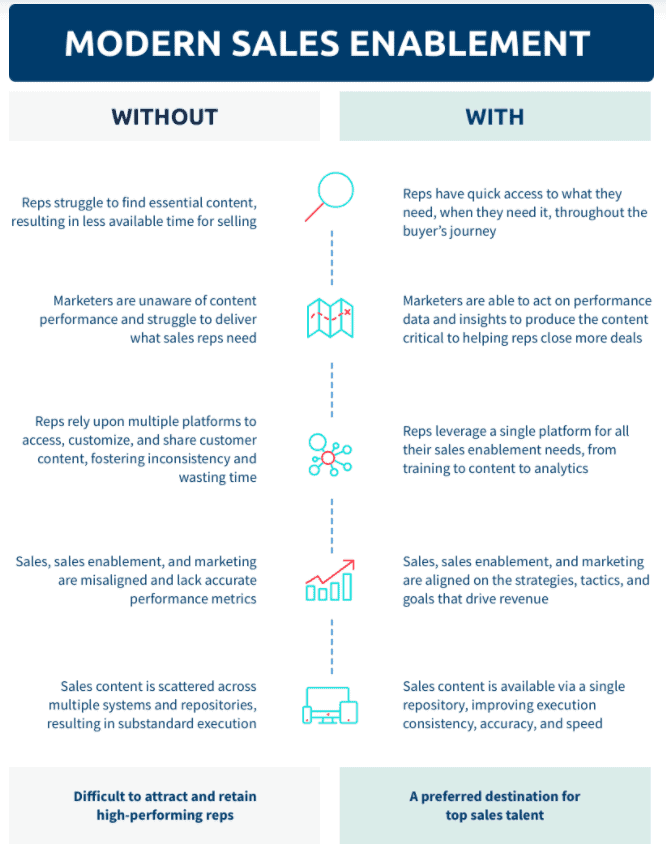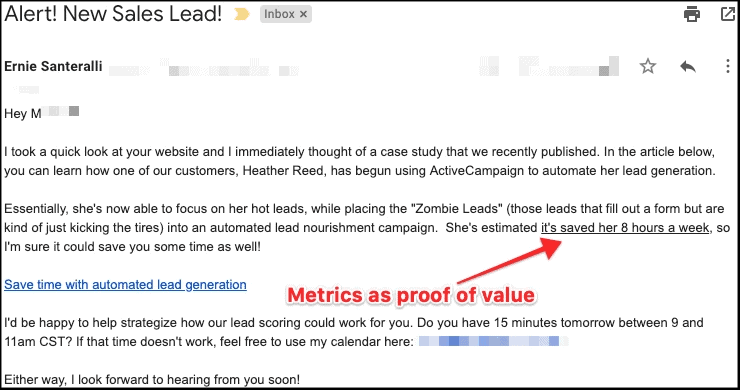As the owner or manager of a business, you know the importance of giving your team all the resources they need to be successful. Better tools in the hands of good people means better efficiency and effectiveness.
This is especially true for your sales team. They need a toolbox of resources to convert leads, make more sales, and drive revenue for your business. How do you provide them with everything they need? Through sales enablement.
What is Sales Enablement?
Sales enablement is the iterative practice of providing sales teams with content and tools that help them sell more efficiently and effectively. The goal is to arm your salespeople with everything they need to usher the buyer through the buying process, ultimately shortening the sales cycle and closing more deals.
The tools you give them usually take the form of content. Sales enablement content can take many forms: articles, videos, audio recordings, podcasts, graphics, charts, etc. It could be information for the sales team (e.g. “‘If a customer raises this objection, say this”) or it could take the form of customer-facing assets (such as a chart that shows them how you compare to your competitors or a calculator to help them evaluate the cost of your products/services).

Both sales and marketing play a role in sales enablement. According to CSO Insights, sales enablement is owned by the sales lead in half of all organizations. In other organizations, those duties fall to someone in marketing or an executive. Some massive companies devout entire teams to sales enablement.
Regardless who leads it, both sales and marketing should collaborate on creating and distributing resources to the sales team. Marketing tends to create a majority of the assets while sales bakes those tools into the sales process.
Sale enablement professionals (or teams) exist to support sellers. How they do that tends to look different in every organization.
9 Reasons Why Sales Enablement is Important
Why should you invest in sales enablement?
- Sales enablement ensures you’re getting the most value out of every interaction with potential clients. For instance, instead of simply telling a client how much they can save, a diagram that compares your service to other options makes your argument clearer and more impactful.
- By empowering your team with resources, assets, and advice, you can help them hit their quotas. They’ll appreciate the support and increased pay that comes with success.
- Employers who provide content to help their teams perform at a higher level tend to have more engaged salespeople. These players think critically about their job and learn to deliver what they learn back to the sales enablement program, thereby improving everyone’s effectiveness.
- A sales enablement program creates an opportunity for high performers (consistent quota hitters) to become mentors and educators within the sales team. For example, you might interview your top salesman on an internal podcast so he or she can help other employees achieve the same results.
- A sales enablement program puts everyone on the same page so your whole team uses the right information during client interactions, thus eliminating confusion. It also creates a central content source for salespeople to pull from. If, for example, you take new product photos, you can simply add them to the sales enablement repository so everyone has updated files.
- Sales enablement reduces the time it takes to onboard new team members. Instead of learning your product/service and process organically, you can instruct them to study the sales enablement content. Instead of producing their own sales assets, they can simply pull from your repository.
- Like most sales teams, you’re probably using your one or several sales tools. Sales enablement resources help employees get the most value out of those tools. You’re already paying for those tools. You ought to use them as effectively as possible.
- The biggest benefit, of course, is increased revenue. If your salespeople have the right tools to maximize their potential, they will close more deals, get more referrals, and ultimately make more money for your company.
- Sales enablement content democratizes your sales system so everyone has access to the best information. This makes you less reliant on a handful of superstars to meet your revenue goals. There will always be exceptional salespeople, but the right support content can raise your average
How to Create Sales Enablement Content
Now that you understand sales enablement and why it’s beneficial to your business, you’re probably wondering how to create the right kind of enablement content.
Sales enablement content can come in a variety of mediums and delivery methods. It depends on the type of customer you sell to, the needs of your sales team, and your sales workflow. Regardless of the form it takes, however, it should be reusable and easy to consume for your team and/or customers.
Here are some of the most common forms of sales enablement content.
Internal podcast
An internal podcast is a podcast made for a specific group of people – in this case, your sales team – as opposed to the general public. You can record episodes that give them tips and information about your customer, your products and services, and how to sell better.
In some respects, distributing an internal podcast is a lot easier than a public-facing show because your audience is fixed. You already have a direct line of communication with those people. Notifying them that a new episode is available is as simple as sending an email.
To get started, however, you’ll need a podcast host (like Castos), some basic podcasting equipment, and our complete guide on starting a podcast.
Case studies
Case studies are some of the most powerful tools in a salesperson’s toolbox. Nothing makes a better argument than a past client’s success.
It’s helpful to have case studies for each type of client. This gives your sales team the ability to show prospects case studies of past clients that resemble their business as close as possible.
Your case studies should also include internal notes for the sales team to help them be more effective. For instance, a case study for a manufacturing firm may include a note that encourages the sales person to rope in the prospect’s lead engineer as quickly as possible because that person must always be consulted. This kind of tip would ultimately shorten the sales cycle.
Here’s a great example of a case study. Notice how it’s brief but impactful. It gives an overview of the client and makes clear note of their successes.

Templates
Templates are pieces of content your sales teams can use to guide their work. These documents keep them organized and moving forward at all times. They also standardize the work across your team so everyone is using the same methods.
- Email templates – Instead of each sales rep spending hours agonizing over the copy in their emails, build and test your own templates for different needs. For example, you might have a template that explains how your wholesale system works. A sales rep would simply copy and paste the content whenever they need it.
- Email sequences – These assets can automatically trigger based on a prospect’s behavior. For instance, after filling out a contact form, a prospect could receive an automatic email to schedule a product demonstration
- Phone scripts/agendas – Talking on the phone is harder than most people think, especially if your sales team has to remember a lot of information. Make their calls more valuable by giving them notes or an exact script to follow.
A basic template like this doesn’t seem like much, but having it on hand can save your sales team a lot of time.

One sheets
A one sheet (also called a sales sheet or a product sheet) is a single page document given to the customer that explains a particular product or service. It’s basically a snapshot of what you’re trying to sell that includes the most relevant and valuable information for that type of customer. If you sell multiple products or services, you should have a one sheet for each.
One sheets are useful because they help your salespeople express the value of your products in a succinct way. It presents your offerings in a clear, focused manner so as not to overwhelm the customer/client.
You can distribute one sheets by either sending them ahead of the first interaction with a sales person or having the salesperson go over it during the first meeting.
In-person sales trainings
In-person sales trainings are one of the most traditional forms of sales enablement content. This is the practice of gathering their sales team and teaching them strategies and techniques to sell better.
Like other forms of sales enablement content, your sales trainings should focus specifically on your customer type. These are best led by sales experts in your industry or salespeople within your organization who have the most experience.
Other Sales Enablement Techniques
Beyond content, here are some other ways you can support your sales team:
- Standardize your reporting. A standard set of sales reports keeps everyone on the same page. It also helps sales leaders understand the strengths and weaknesses of each person on the sales team.
- Automate your prospecting. Instead of reaching out by hand, use email automation to make the first touch with potential customers. Include direct links to the sales person’s calendar so prospects can schedule a call or product demonstration. This lets sales people focus on higher level tasks.
- Review your sales process. Look for bottlenecks or weak points in your typical sales process and take steps to optimize them. For instance, if your demos fail to close deals, look for ways to improve your demo.
- Qualify your leads better. If your team is constantly trying to sell to poor-fit clients, implement lead scoring systems rank prospects based on the likelihood of closing a deal. Salespeople can focus on the most ideal clients and only worry about poor-fit clients when they’ve exhausted all other leads.
- Organize your sales enablement content. Ideally, you want a single repository of information your sales team can pull from. This ensures everyone is using the same information that’s current and relevant.
Empower Your Sales Team
It’s important to enable your sales team with the right resources, skills, and tools to make them as effective and productive as possible. Sales enablement will help them close more deals and ultimately boost your revenue. Every minute you spend developing sales enablement content is time you get back in spades as your team starts to perform at a higher level.


